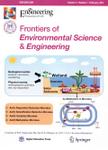A multi-integrated approach on toxicity effects of engineered TiO2 nanoparticles
A multi-integrated approach on toxicity effects of engineered TiO2 nanoparticles作者机构:LNEG-National Laboratory of Energy and Geology I.P. Lisbon 1649-038 Portugal REQUIMTE Chemistry Department Fine Chemistry and Biotechnology Center Faculty of Sciences and Technology New University of Lisbon Caparica 2829-516 Portugal IMAR-Ocean Institute Department of Sciences and Environmental Engineering Faculty of Sciences and Technology New University of Lisbon Caparica 2829-516 Portugal CENIMAT/I3N and Department of Materials Science Faculty of Sciences and Technology New University of Lisbon Caparica 2829-516 Portugal Pathological Anatomy Curry Cabml Hospital Lisbon 1069-166 Portugal CESAM Faculty of Sciences Lisbon University Lisbon 1749-016 Portugal
出 版 物:《Frontiers of Environmental Science & Engineering》 (环境科学与工程前沿(英文))
年 卷 期:2015年第9卷第5期
页 面:793-803页
核心收录:
学科分类:081702[工学-化学工艺] 07[理学] 070205[理学-凝聚态物理] 08[工学] 0817[工学-化学工程与技术] 080501[工学-材料物理与化学] 0805[工学-材料科学与工程(可授工学、理学学位)] 0702[理学-物理学]
基 金:funded by FCT-Fundacao para a Ciencia e a Tecnologia
主 题:ecotoxicity enzymatic analysis histology,transmission electron microscopy (TEM) TiO2-nanoparti-cles
摘 要:The new properties of engineered nanoparti- cles drive the need for new knowledge on the safety, fate, behavior and biologic effects of these particles on organisms and ecosystems. Titanium dioxide nanoparticles have been used extensively for a wide range of applica- tions, e.g, self-cleaning surface coatings, solar cells, water treatment agents, topical sunscreens. Within this scenario increased environmental exposure can be expected but data on the ecotoxicological evaluation ofnanoparticles are still scarce. The main purpose of this work was the evaluation of effects of TiO2 nanoparticles in several organisms, covering different trophic levels, using a battery of aquatic assays. Using fish as a vertebrate model organism tissue histological and ultrastructural observations and the stress enzyme activity were also studied. TiO2 nanoparticles (Aeroxide~ P25), two phase composition ofanatase (65%) and rutile (35%) with an average particle size value of 27.64-11 nm were used. Results on the ECs0 for the tested aquatic organisms showed toxicity for the bacteria, the algae and the crustacean, being the algae the most sensitive tested organism. The aquatic plant Lemna minor showed no effect on growth. The fish Carassius auratus showed no effect on a 21 day survival test, though at a biochemical level the cytosolic Glutathione-S-Transferase total activity, in intestines, showed a general significant decrease (p〈0.05) after 14 days of exposure for all tested concentrations. The presence of TiO2 nanoparticles aggregates were observed in the intestine lumen but their internalization by intestine cells could not be confirmed.



